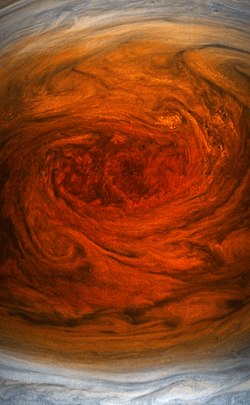Telescopes and Spacecraft Join Forces to Probe Deep into Jupiter's Atmosphere (49892941386)
NASA's Hubble Space Telescope and the ground-based Gemini Observatory in Hawaii have teamed up with the Juno spacecraft to probe the mightiest storms in the solar system, taking place more than 500 million miles away on the giant planet Jupiter.
These images of Jupiter's Great Red Spot were made using data collected by the Hubble Space Telescope and the Gemini Observatory on April 1, 2018. By combining observations captured at almost the same time from the two different observatories, astronomers were able to determine that dark features on the Great Red Spot are holes in the clouds rather than masses of dark material.
Upper left (wide view) and lower left (detail): The Hubble image of sunlight (visible wavelengths) reflecting off clouds in Jupiter’s atmosphere shows dark features within the Great Red Spot.
Upper right: A thermal infrared image of the same area from Gemini shows heat emitted as infrared energy. Cool overlying clouds appear as dark regions, but clearings in the clouds allow bright infrared emission to escape from warmer layers below.
Lower middle: An ultraviolet image from Hubble shows sunlight scattered back from the hazes over the Great Red Spot. The Great Red Spot appears red in visible light because these hazes absorb blue wavelengths. The Hubble data show that the hazes continue to absorb even at shorter ultraviolet wavelengths.
Lower right: A multiwavelength composite of Hubble and Gemini data shows visible light in blue and thermal infrared in red. The combined observations show that areas that are bright in infrared are clearings or places where there is less cloud cover blocking heat from the interior.
Read more: <a href="https://go.nasa.gov/2xZzX78" rel="noreferrer nofollow">go.nasa.gov/2xZzX78</a>
Credit: NASA, ESA, and M.H. Wong (UC Berkeley) and team
<a href="https://go.nasa.gov/3fOvG7N" rel="noreferrer nofollow">NASA image use policy.</a>
<a href="https://go.nasa.gov/2YXL3op" rel="noreferrer nofollow">NASA Goddard Space Flight Center</a> enables NASA’s mission through four scientific endeavors: Earth Science, Heliophysics, Solar System Exploration, and Astrophysics. Goddard plays a leading role in NASA’s accomplishments by contributing compelling scientific knowledge to advance the Agency’s mission.
Follow us on <a href="https://go.nasa.gov/3bq5yfW" rel="noreferrer nofollow">Twitter</a>
Like us on <a href="https://go.nasa.gov/2y3Sdwg" rel="noreferrer nofollow">Facebook</a>
Find us on <a href="https://go.nasa.gov/3bzDsPf" rel="noreferrer nofollow">Instagram</a>Relevante Bilder
Relevante Artikel
Großer Roter FleckDer Große Rote Fleck ist ein auffälliger und langlebiger Sturm in Jupiters Atmosphäre. Meteorologisch gesehen ist er ein Hochdrucksystem auf der Südhalbkugel des Planeten. Dieses System erzeugt einen antizyklonalen Sturm, welcher der größte im Sonnensystem ist. Er befindet sich in der südlichen Tropenzone und ist etwa eineinhalb mal so breit wie der Durchmesser der Erde. Die Windgeschwindigkeiten betragen bis zu 680 km/h. Erste Beobachtungen eines Flecks auf Jupiter stammen aus der Zeit von 1665 bis 1713. Es ist unklar, ob es sich damals um denselben Sturm handelte wie der seit dem 19. Jahrhundert beobachtete Große Rote Fleck. Sollte dies zutreffen, dann existiert er seit über 350 Jahren. Erst 1831 wurde er das nächste Mal von Samuel Heinrich Schwabe beobachtet, und zwischen diesem Zeitpunkt und 1878, als die kontinuierliche Beobachtung begann, wurden 60 Beobachtungen aufgezeichnet. Ab den 1970er Jahren bekam Jupiter Besuch von etlichen Raumsonden wie Voyager, Galileo, Cassini und Juno, die detaillierte Aufnahmen und weitere Messungen des Sturms durchführen konnten. .. weiterlesen




















